
views
X
Research source
Initializing is the process of giving a variable an initial value. If you don't initialize, you'll likely get errors in your code, but thankfully, each list initialization method is straightforward. In this article, we will cover 7 ways to initialize a list (or an array that looks like a list) in Java.
- You cannot add to a List, but you can create an array that looks like a List that can be added to later.
- Lists can hold various data types, such as strings, integers, floats, doubles, and more.
- The "add()" and "ArrayList" methods can be used with some other methods to create mutable lists.
add() to an ArrayList
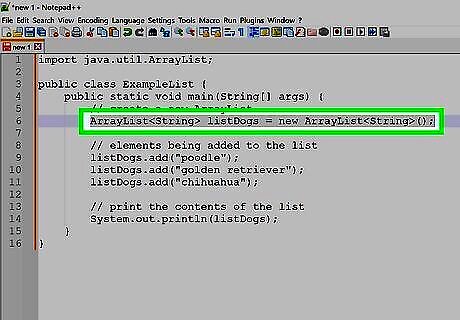
Create an ArrayList. If you already have an ArrayList you can skip this, but if not, create one. Use the following code snippet to create your ArrayList where
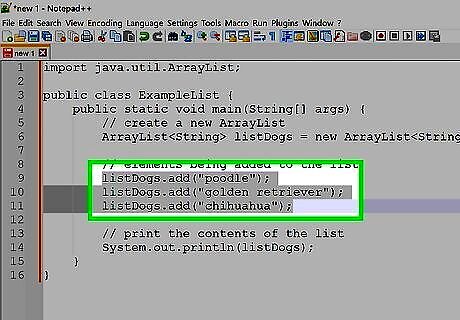
Add elements to the list with the add() method. The add() method can be used to add elements to a list (or various other types of collections). The add() method allows you to add one element at a time and is an easy way to initialize your list with some values.
Below is an example of how to use the add() method to add some string values to a list. Replace ExampleList, listDogs, and the arguments "poodle", "golden retriever", and "chihuahua" with your own data.
import java.util.ArrayList;
public class ExampleList {
public static void main(String[] args) {
// create a new ArrayList
ArrayList
Arrays.asList()
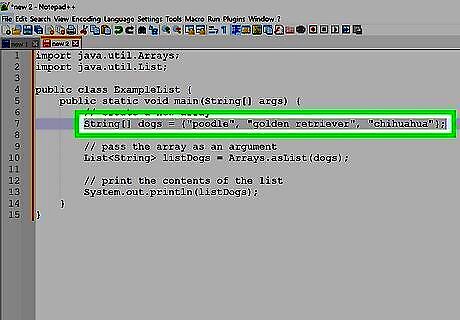
Declare an array with some initial elements. The Array.asList() method will convert an array into a List collection. This List is immutable, which means you cannot add or remove elements from it. String[] dogs = {"poodle", "golden retriever", "chihuahua"};
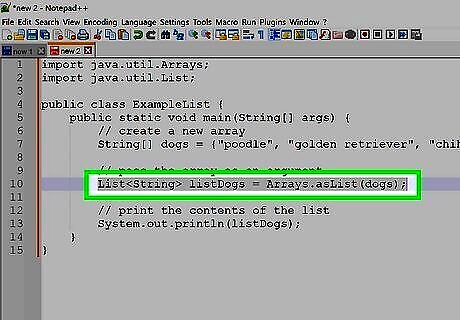
Call the Arrays.asList() method. The array you created will be used as the argument for this method.
List
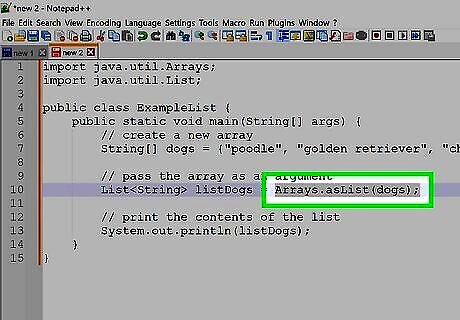
Use the object you created to access the element. You can use this object to print the list, for example. The complete snippet to print this list using the Arrays.asList() method is below. Replace dogs, listDogs, and the arguments "poodle", "golden retriever", and "chihuahua" with your own data.
import java.util.Arrays;
import java.util.List;
public class ExampleList {
public static void main(String[] args) {
// create a new array
String[] dogs = {"poodle", "golden retriever", "chihuahua"};
// pass the array as an argument
List
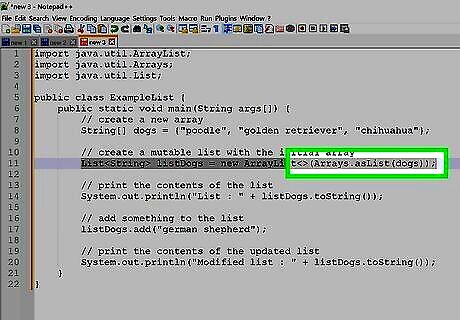
Create a mutable list by combining ArrayList and Arrays.asList(). By using the Arrays.asList() method as an argument for a new ArrayList, you can combine methods to make a list that can be changed (a mutable list).
Use the following code snippet to make your mutable list:
List
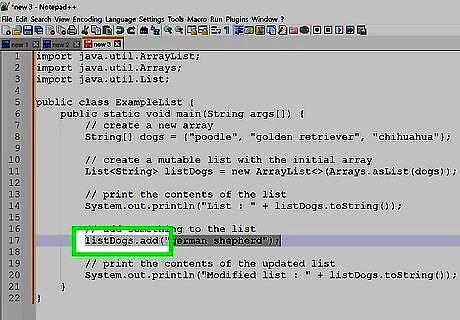
Use the add() method to add to your list. The following code will print your initial list and your modified list. Remember to add each new element with a separate add() method.
import java.util.ArrayList;
import java.util.Arrays;
import java.util.List;
public class ExampleList {
public static void main(String args[]) {
// create a new array
String[] dogs = {"poodle", "golden retriever", "chihuahua"};
// create a mutable list with the initial array
List
Collections.addAll()
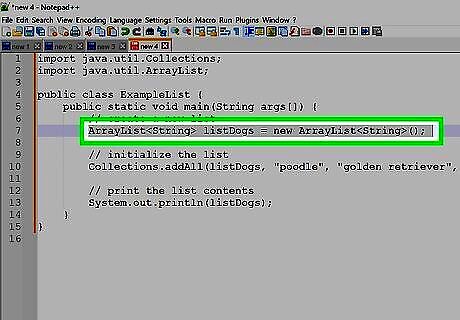
Create a new list. You can use either ArrayList or List, though we've used ArrayList for this example. Using either one will still allow this list to be mutable.
ArrayList
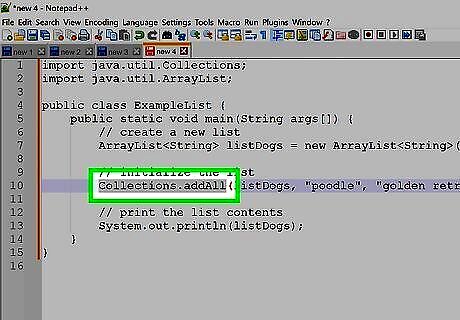
Initialize the list using Collections.addAll(). This method first defines the collection (ArrayList or List) and then includes the elements that should be included in the list. Collections.addAll(listDogs, "poodle", "golden retriever", "chihuahua");
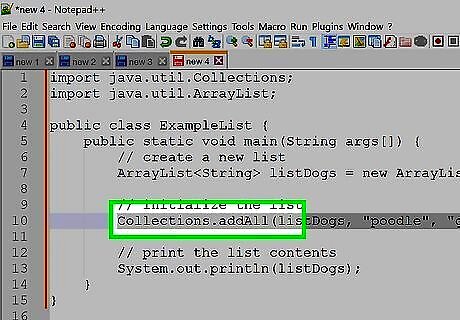
Combine the list and the Collections.addAll() method. You can print the list you've created like the methods before. Replace ExampleList, listDogs, and the arguments "poodle", "golden retriever", and "chihuahua" with your own data.
Note that if you used List instead of ArrayList, add import java.util.List; to the top of your code. You must keep the ArrayList package, as it's utilized in creating your list.
import java.util.Collections;
import java.util.ArrayList;
public class ExampleList {
public static void main(String args[]) {
// create a new list
ArrayList

Use the add() method to add to your list. The following code will print your initial list as well as your modified list. Remember to add each new element with a separate add() method.
import java.util.Collections;
import java.util.ArrayList;
public class ExampleList {
public static void main(String args[]) {
// create a new list
ArrayList
Collections.unmodifiableList()
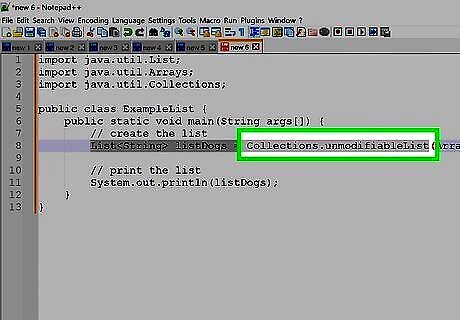
Create an immutable list using unmodifiableList(). If you want a list that cannot be altered, you can use the unmodifiableList() method with the Collections class.
List
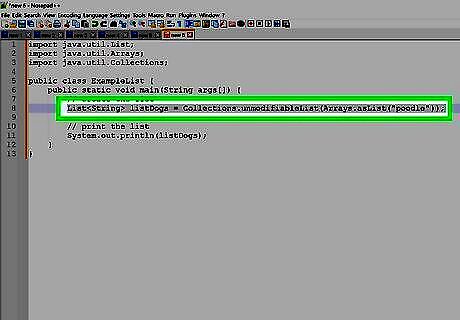
Add the list to your code. Once you've set this list, you cannot change it using add() or any other method. Replace ExampleList, listDogs, and the arguments "poodle", "golden retriever", and "chihuahua" with your own data.
import java.util.List;
import java.util.Arrays;
import java.util.Collections;
public class ExampleList {
public static void main(String args[]) {
// create the list
List
Collections.singletonList()
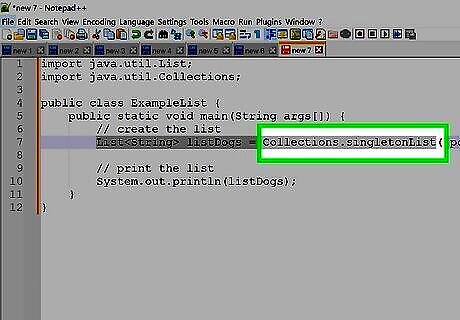
Create a list with one element using singletonList(). If you want a list that holds only one element, you can use the singletonList() method with the Collections class. This list is immutable.
List

Add the list to your code. Once you've set this list, you cannot change it using add() or any other method. Replace ExampleList, listDogs, and the arguments "poodle", "golden retriever", and "chihuahua" with your own data.
import java.util.List;
import java.util.Collections;
public class ExampleList {
public static void main(String args[]) {
// create the list
List
Stream.of() (Java 8)

Use the Stream.of() method introduced in Java 8. There are a few syntaxes you can use with Stream.of(), but all of them start with the same code snippet:
List
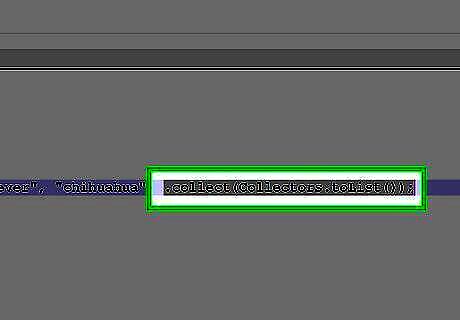
Complete your Stream.of() method. You can end the method in three ways using the {{kbd|collect()} method. These methods will all return similar-looking lists, though each one works a bit differently: .collect(Collectors.toList()); collects the elements and displays them as a list. .collect(Collectors.toCollection(ArrayList::new)); collects the elements and displays them as an array. .collect(Collectors.collectingAndThen(Collectors.toList(),Collections::unmodifiableList)); collects the elements and displays them as an immutable list.
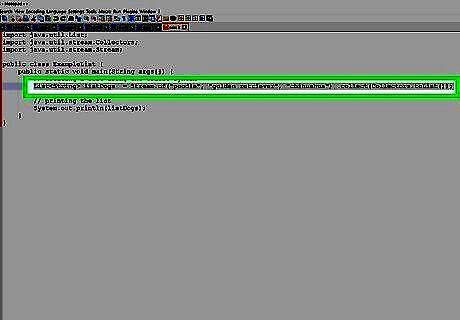
Add the Stream.of() list into your code. The example below completes the stream with .collect(Collectors.toList());; if you'd like to use a different method, replace .collect(Collectors.toList()); with the method of your choice from the list above.
Replace ExampleList, listDogs, and the arguments "poodle", "golden retriever", and "chihuahua" with your own data.
import java.util.List;
import java.util.stream.Collectors;
import java.util.stream.Stream;
public class ExampleList {
public static void main(String args[]) {
// creating a list using the toList syntax
List
List.of() (Java 9)
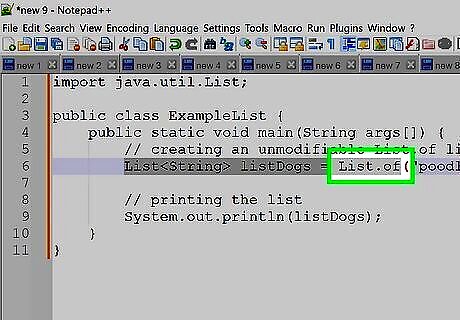
Create an unmodifiable list using List.of(). With Java 9, you can use the List.of() method to create a simple, unmodifiable list.
List

Combine the list with the rest of your code. You can print your immutable list by using the following code. Replace ExampleList, listDogs, and the arguments "poodle", "golden retriever", and "chihuahua" with your own data.
import java.util.List;
public class ExampleList {
public static void main(String args[]) {
// creating an unmodifiable List.of list
List




















Comments
0 comment